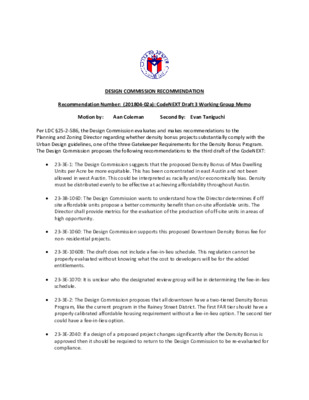2018 Design Commission Recommendation — original pdf
Backup

DESIGN COMMISSION RECOMMENDATION Recommendation Number: (201804‐02a): CodeNEXT Draft 3 Working Group Memo Motion by: Aan Coleman Second By: Evan Taniguchi Per LDC §25‐2‐586, the Design Commission evaluates and makes recommendations to the Planning and Zoning Director regarding whether density bonus projects substantially comply with the Urban Design guidelines, one of the three Gatekeeper Requirements for the Density Bonus Program. The Design Commission proposes the following recommendations to the third draft of the CodeNEXT: 23‐3E‐1: The Design Commission suggests that the proposed Density Bonus of Max Dwelling Units per Acre be more equitable. This has been concentrated in east Austin and not been allowed in west Austin. This could be interpreted as racially and/or economically bias. Density must be distributed evenly to be effective at achieving affordability throughout Austin. 23‐3B‐1060: The Design Commission wants to understand how the Director determines if off site affordable units propose a better community benefit than on‐site affordable units. The Director shall provide metrics for the evaluation of the production of off‐site units in areas of high opportunity. 23‐3E‐1060: The Design Commission supports this proposed Downtown Density Bonus fee for non‐ residential projects. 23‐3E‐1060B: The draft does not include a fee‐in‐lieu schedule. This regulation cannot be properly evaluated without knowing what the cost to developers will be for the added entitlements. 23‐3E‐1070: It is unclear who the designated review group will be in determining the fee‐in‐lieu schedule. 23‐3E‐2: The Design Commission proposes that all downtown have a two‐tiered Density Bonus Program, like the current program in the Rainey Street District. The first FAR tier should have a properly calibrated affordable housing requirement without a fee‐in‐lieu option. The second tier could have a fee‐in‐lieu option. 23‐3E‐2040: If a design of a proposed project changes significantly after the Density Bonus is approved then it should be required to return to the Design Commission to be re‐evaluated for compliance. 23‐3E‐2050: The Design Commission recommends that the Community Benefit requirements be expanded to include all projects opting into the Density Bonus Program. 23‐3E‐2050: The Design Commission recommends that the Community Benefit options include mobility alternatives that support biking, and pedestrian transit, and manages off street parking and ride‐share loading availability to reduce street traffic and support Vision Zero’s mission to reduce pedestrian fatalities. If they are not providing on site affordable housing, the applicant should also be required to file a restrictive covenant agreeing to provide more Community Benefits. 23‐3E‐2060E1c: A sales price of 3.5 times the annual income of a household at 120 percent MFI is not affordable. This is well over what most middle‐class families can afford and must be re‐ evaluated. Why is this so much higher than the amount outlined in the Proposed Administration Procedures for Affordable Housing Bonus Program document on the CodeNEXT website? It says 3.5 times 80 percent MFI. 23‐3E‐4020D1: Why is the location of affordable housing in “high opportunity areas” left to the discretion of the Housing Director? This process should be transparent and clearly defined. How will these decisions be measured against land that could provide equivalent opportunity? 23‐4D‐5010: The Commission recommends that all properties along Imagine Austin Corridors be included in the Affordable Housing Bonus Program. (Draft 3 maps zone some corridors MS2B which prohibits using the Affordability Housing Bonus Program.) 23‐9C‐2020A: The Commission supports lowering the threshold for triggering a Traffic Impact Analysis. 23‐3E‐4060: The Design Commission recommends that the Housing Director establish a systematic approach for reporting, compliance and enforcement of SMART Housing policy and program, to be approved by City Manager. The Housing Director shall provide an annual report to Council regarding status of SMART Housing program. • 23‐4C‐1030: The Design Commission recommends that the Planning Commission support the staff recommendation for Common Open Space requirements with the added language that it may count towards a project’s Functional Green or Parkland Dedication requirements; thereby eliminating the fee‐in‐lieu. Additionally, we recommend that staff better illustrate how Common Open Space can count towards the Private Open Space and Civic Open Space requirements. • 23‐3E‐2040: The Design Commission recommends that the Planning Commission support staff’s recommendation that the Design Commission remain as gatekeeper of the Urban Design Guidelines and thereby reviewing all Downtown Density Bonus projects for conformance. The Design Commission is the only peer review these projects receive and past applicants have improved their projects significantly based on the Commission’s comments. Removal of the Design Commission from this process will result in less community benefits in exchange for the large increases in entitlements being given away. • The Design Commission recommends that the Director thoughtfully consider recommendations from Design Commission and provide written determinations on how the applicant substantially achieved compliance with the Urban Design Guidelines if the Director does not accept the Design Commission recommendations. For these contested projects, the final decision should be made by Council. • The Design Commission recommends keeping track of revisions made to Density Bonus projects made after approval by Design Commission, but before issuance of building permit. The continued cycle of reporting how recommendations have been implemented through construction ensures affordability and community benefits are executed. Keeping historic data on affordable units generated by density bonus program (off site and on site) helps establish precedent to improve on the program’s implementation. • To the maximum extent possible, The Director of Housing should utilize community‐based nonprofits to produce affordable housing related to the Density Bonus Program. • Overall, there is too much reliance on the Director’s decision/discretion in many of these Sections. There should be some oversight of the Director’s decisions, possibly Planning Commission or Council. Thank you for this opportunity to participate in the CodeNEXT process. Date of Approval: ________5‐18‐2018____________ Vote: 6‐0 For: Evan Taniguchi, Aan Coleman, David Carroll, Martha Gonzalez, Melissa Henao‐Robledo, and Ben Luckens Against: n/a Abstain: n/a Absent: Katie Halloran, Bart Whatley Beau Frail, Samuel Franco Attest: _____________________________________________ David Carroll, AIA Chair, City of Austin Design Commission